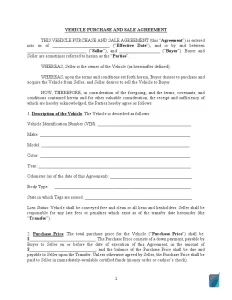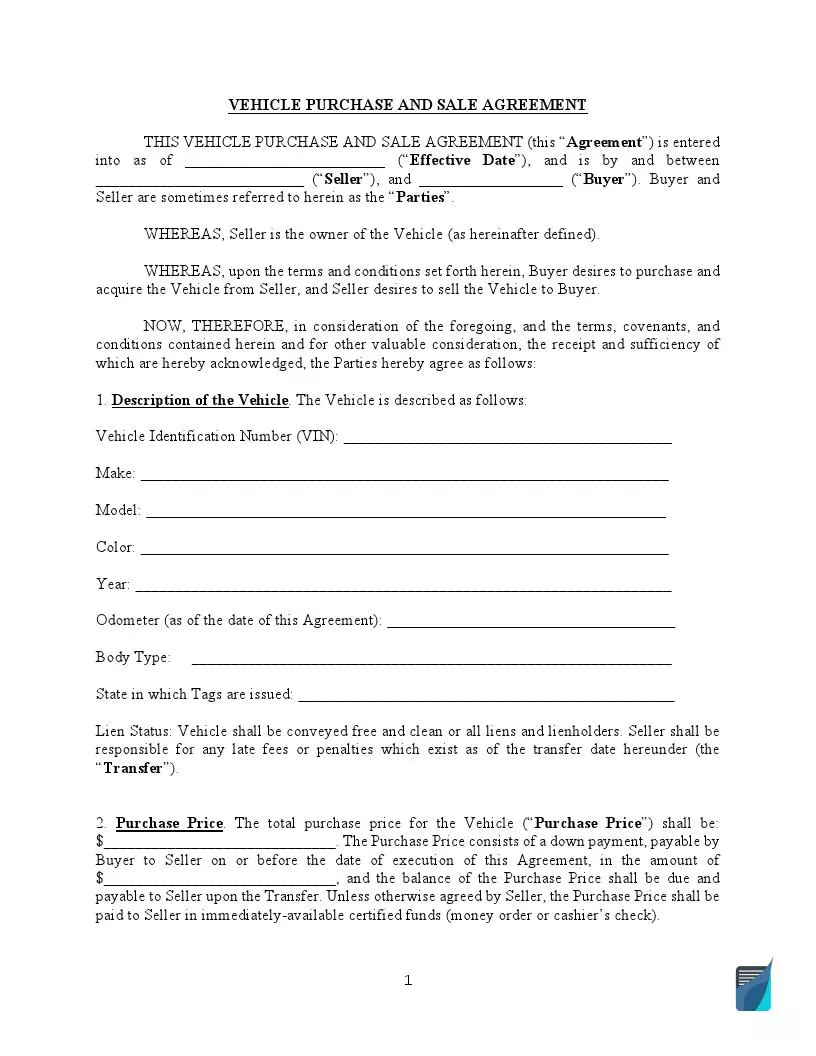Vehicle Purchase Agreement Template
A car purchase agreement is a legally-binding contract that serves to set the verbal agreements between buyer and seller of a motor vehicle in writing. It’s not a document that transfers ownership between the two. This contract only specifies the intention to go through with the sale, and that’s why it’s often called a sales agreement or sales contract.
If that sounds like legal jargon to you right now, don’t feel overwhelmed. Continue with this ten-minute read to find more about vehicle purchase agreements, why is it a good way to deal with car dealerships, and how to fill one out. You can also download a free car purchase agreement template or create a custom one.
What Is a Vehicle Purchase Agreement?
When you pay in cash or credit and receive a used car at a dealership lot or a private party sales, you also receive a bill of sale or a pink slip with it. This printable purchase and sale agreement transfers the ownership of the vehicle from the seller to the buyer. But before going through with the transaction and making a payment, you can sign a sale agreement.
As the name suggests, this contract outlines all the details of the upcoming car purchase and indicates the agreement between the parties to commit to selling and buying the vehicle. As such, this document will contain information on the way of payment, the date of payment, and the sales price. It will also include information about free items you can get with the said vehicle and the fees you may have to pay to the dealership.
Why would you want to make an act as simple as buying and selling a used car so complicated, though? Wouldn’t a simple verbal agreement do? Well, there are a couple of reasons.
Why Use a Vehicle Purchase Agreement?
One reason to create a legally-binding contract to outline the details of a vehicle purchase is to make sure that the dealer doesn’t sell it to somebody else. It may be the case that you’ve found your dream car but don’t have the money to purchase it now and trade-in is not an option. In this case, the dealer won’t have the legal right to sell the car until the time specified in the car sales contract.
Another reason could be that you want to sign a contract for purchase is if you need an expended payment period for financing your vehicle and don’t want to get banks involved. With a car purchase agreement, you can negotiate a payment plan with your dealership and pay in parts as per the contract.
Last but not least, signing a contract like this would prevent shady practices between buyer and seller. Sometimes, dealerships would charge extra fees on top of the total purchase price for the vehicle. If those fees are not outlined in the contract, you are not required to pay a dime over the total sum. Since the contract is legally-binding, the dealership will have to claim it even if they were to take it to court.
Vehicle Purchase Agreement vs. Vehicle Bill of Sale
The difference between the vehicle purchase agreement and bill of sale is both in timing and purpose. The bill of sale is used to transfer the ownership of a car from seller to buyer after the sale is made. This document is a bit different. It declares the agreement between the two parties to buy and sell a vehicle. It also declares when the payment and transaction are going to take place, how payments should be made, and what fees should be paid to the dealer.
How to Use a Car Purchase Agreement
Creating and signing a car purchase agreement is just a part of the deal, however. This is only a document that gives you peace of mind that should the acquired vehicle be not in the condition you were promised at the dealership, you can win in court. However, it’s best to start the process of car purchase by doing due diligence to avoid going to court whatsoever. Here’s how you go about it.
Set up your budget
The first thing to do is to think about how much money can you set aside for a new car. That’s out of the scope of legal matters pertaining to this field, but it’s necessary not to get hooked on the sales tactics at the dealership.
Find your ideal car
The next step in the process is finding your ideal car. You can use the websites of local dealers or drive around in person to see what they have on the menu. Don’t go for the first one you see, though. Spend a day choosing cars to make sure you get the best deal not the first best thing you saw at the dealers.
Do a checkup
Now, don’t buy what the salespeople tell you. Unless they set their words in writing, it’s all just suggestions, not genuine information. Instead of trusting the friendly person trying to sell you a car, do a quick checkup on it yourself. Pay attention to the following things in your motor vehicle:
- Oil stains underneath the car
- Signs of covered up corrosion
- Loose plastic details inside
- Worn out tires
- Worn out window seals
- Messy dirty engine — it may have never been to a mechanic
Test drive it
Looking at a vehicle never really lets you understand it as well as driving it. If it doesn’t seem like the one you’re looking at has a problem, hop in for a quick test drive.
Negotiate the price
If you end up loving the test drive, it’s time to negotiate a price. Normally, you can get a couple of hundred bucks off of a used car in most states. You can also discuss the possibility of purchasing the car on a payment plan. In this case, be very specific about the downpayment size and monthly payments. Make sure that the dealership tells you about extra fees so that the total purchase price on the car purchase contract doesn’t go up higher than expected. Note that you should include a sales tax on the sum total.
Create a car purchase agreement
Once the deal is struck, you need to set it in stone. With a car purchase agreement signed by both parties, it would be impossible for the dealership to come up with additional fees that were never initially discussed.
Make sure to include anything and everything that pertains to the transaction when constructing the agreement. When you’re done with the sales agreement, check it a couple of times for mistakes and data entry errors.
Sign the deal
Once you have the sales agreement ready, read it thoroughly and sign it. If you’re going to have a co-owner for a newly acquired vehicle, they should co-sign as well.
Close the deal with the transfer date comes
With that out of the way, all you have left to do is to show up on the specified date to close the deal, pay the sum either in full or deposit down payment, and get your bill of sale and keys.
What Are the Main Components of the Agreement?
Unlike some other contracts, vehicle sales contracts often have a simplified form and a rather typical layout. You can, however, negotiate with your car dealer to have a custom contract. No matter what provisions do you put in the document, it does need to have a range of details to be deemed legally binding and effective. A car sale contract typically consists of the following elements.
- Name and personal information of buyer and seller
- Description of the vehicle that includes VIN number, year, make, model, etc.
- Odometer reading
- Previous damage to the acquired vehicle
- State that issued the number plates
- The total sum that includes the overall sales price and doc fee
- Date of closing the deal
If the transaction involves a different mode of payment like trade-in or money order, the car sale agreement should reflect that as well.

Filling Out the Vehicle Purchase Agreement Template
It’s okay if your document is not a custom one but a simple form instead. You can get one here for free, and use it for most car purchases save for ones with extremely unique conditions. Here’s how you fill out the template.
Step 1. Identify the buyer and seller name and address
First, write your name and address. Make sure it’s the address you’re permanently living at and can use it to receive mail.
Step 2. Describe the vehicle
The longest part you’ll have to fill out is the description of the acquired vehicle. The dealer should fill in the VIN number, make, year, and model of the vehicle, as well as its color and body type. They should also add the current odometer reading and the state that issued the number plates.
Make sure everything is filled in correctly.
Step 3. Write the purchase price and down payment
With that out of the way, you have very few steps to go through. First, fill in the full price for the vehicle (it should include doc fees and other fees the dealership charges). If you’re settling on monthly payments, it’s now the time to elaborate on that and provide the down payment sum.
Step 4. Indicate the transfer date
The next step is to write in the date of the intended purchase. Make sure you can come pick up the car on that date as you don’t want to violate the agreement.
Step 5. Disclose
This portion should be filled out by the dealer, but make sure you check on how rigorously do they do it. The dealer is obliged to explain any accidents the car has been in or any malfunctions it may have at the moment.
Step 6. Read the document carefully
That’s it, the template is filled in now. All you have left to do is re-read it carefully. Make sure everything is typed in correctly and the sum is not higher than it was agreed upon.
Step 7. Sign it
If the previous step went well, you should now have a document that would grant you the right to your dream car. Go ahead and sign it. Come back when the transfer date comes, proceed with the payment, and the car is yours. Don’t forget to collect the bill of sale.
